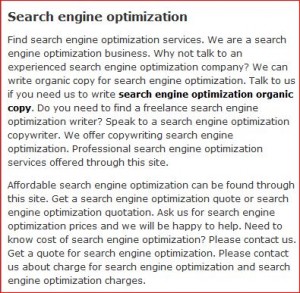Entries from March 2011 ↓
March 30th, 2011 — copywriter, copywriting tips, email copywriting, email marketing, UK copywriter
 If your business is new to email marketing working out how to get people to open your emails can be a real headache.
If your business is new to email marketing working out how to get people to open your emails can be a real headache.
Mind you, you don’t even have to be a newcomer to email marketing to feel the frustration.
The problem is the success of your email all comes down to the recipient, the type of day they are having and the amount of time they have.
Little wonder then why it can seem an up hill struggle to get your emails opened and read.
Improve your email open rates
This is a short list of 5 very simple things you can do to give your email open rate a boost. Some of them may seem obvious but I think it helps every now and then to restate what many people over look.
1. When?
The day on which you send your mail will have a big effect on whether it’s opened or not.
Generally speaking Mondays and Fridays are not good days. On a Monday most people are wading through emails that weren’t cleared the week before, came in over the weekend or they just haven’t gotten into gear yet.
Fridays are bad because people are winding down for the weekend and they don’t have time to read your email.
So, in general, the best days to send are Tuesday, Wednesday or Thursday.
2. Subject line
Subject lines are difficult to write. Not only do they have to grab attention and make the recipient want to open your email, they also have to avoid spam filters.
Including things like ‘discounted offer’ or ‘free product’ or ‘free trial’ will get attention but you must test them to make sure they don’t trip any spam filters.
Another good way of drawing attention to your email is by using your brand name – especially if it’s one the recipient will instantly recognise.
3. How often?
When’s too much or too little?
Getting the frequency right is vital. As a general rule, once a month is ideal. If you bombard your readers with several emails a week they’ll soon get fed up and unsubscribe.
Equally if you send them only once every 6 months or so (or at random intervals) they may forget they’d subscribed in the first place and delete it.
4. List
Your list – who you email to – is vital which is why it’s always best to build your own rather than buy one in.
If someone has signed up for your emails there’s a pretty good chance they want to hear from you. if you buy in a list you are ‘cold emailing’ and they’ll probably end up being deleted.
5. Ask
Sending out emails willy-nilly is fine if you just want to fill them with stuff you want to say. But what about what your reader what’s to hear?
Every so often its good practice to ask them what they want to see so you can be sure the information you are passing to them is what they want to read.
Email marketing is great if you get it right but it takes time to perfect.
Sally Ormond – freelance copywriter
March 28th, 2011 — copywriter, copywriting, copywriting tips, marketing, sales writing, UK copywriter
Can you really tell whether copy is good or bad just by looking at it?
The answer is yes and no.
It rather depends on what the copy is, what it’s meant to do and what form it takes.
For example if it’s SEO copywriting and it’s very obvious what the targeted keyword is, like in the example below…

…then it’s pretty safe to say it’s bad copy.
The problem is a section of text can be very well written (grammatically correct and no spelling errors) and yet, from a sales perspective, it’s about as useful as a chocolate teapot.
That’s why it’s not always easy to spot bad copy.
It’s probably easier to look at this from a different angle and think about what makes good copy.
The traits of good copy
Luckily there are 5 characteristics that good copy has. No matter which format it’s written for or what it’s trying to sell, good copy will always:
- Grab the readers’ attention immediately
- Be clear and unambiguous
- Answer all the readers’ questions and so counter any buying objections they may have
- Build trust and rapport with the reader
- Motivate the reader into taking a specific action through a strong call to action
What it comes down to is this – copy is written for a purpose (generally to sell something) but if it doesn’t fulfil that purpose it’s not doing its job.
Selling through text alone is difficult. You don’t have the personal contact with the customer; you can’t think on your feet to counter their buying objections and you can’t shake their hands.
Your copywriting has to do every thing:
- Inform
- Build trust
- Convince
- Convert into a sale
That’s not an easy thing to achieve.
What are your thoughts? Can you think of any more traits you find in good copy? Why not share them here along with any shocking examples of copy you’ve come across.
March 25th, 2011 — copywriting tips, social media, social media marketing, social media training, social networking
 Do you need a parachute when you jump out of a plane?
Do you need a parachute when you jump out of a plane?
Every business, if they engage in social media, needs a policy in place.
The social media channels you use are a direct line to your consumers (and competitors). Everything happens in real time – as soon as you hit send your message or tweet goes out to potentially thousands of people.
Get your message wrong and you could find yourself in serious hot water.
The implementation of a social media policy will help protect your company by:
- Ensuring you can avoid PR nightmares
- Making sure all your employees know what you expect of them
- Keeping you out of legal hot water
- Protecting confidential or sensitive information about your company
You must decide what your company’s line will be in the case of defamatory comments being made about it.
How will you react to positive comments?
Who will be monitoring your social media activity and who will be engaging with your followers?
Social media is an excellent tool for businesses to use but, especially for larger companies, it can be a potential mine field so you must ensure you have a social media policy in place before you begin to dabble.
Before you go any further check out this useful post on Mashable – 10 Must Haves For You Social Media Policy.
Engage and enjoy social media, but make sure everyone knows what they’re doing.
March 23rd, 2011 — copywriter, copywriting, copywriting tips, website copywriter, website copywriting

Many businesses think their website copy has to be stiff and corporate.
They want to come across as professional so they must use language that impresses.
As they write their copy they thumb through the pages of their much loved thesaurus to find the most impressive words possible.
Oh boy.
How many times have I seen that? And you know what? They are the websites that under perform because no one wants to read them because they are boring. The language is stale – it’s not interesting, it’s not inspiring and it certainly won’t make the reader think “wow, I really want to do business with these people.”
Be a friend
The best way to get your readers on your side is by chatting with them.
Conversational copywriting will make your website more accessible. It gives your company a distinctive voice – something your readers can relate to.
It’s like slipping on your favourite slippers. They’ll stay longer and they’ll read more because you are talking to them and not at them.
So how can you achieve chatty copy?
- Find out who your target market are and use their vocabulary
- Use short, clear sentences to get your message across
- Don’t use big words – throw away the thesaurus and use language everyone understands
- Read your copy out loud to check it makes sense, has rhythm and doesn’t contain any errors
- Use real language, not a literary version of it
Basically write as you would talk – go over the conversation you would have with the customer if you were stood in front of them and write it down.
March 21st, 2011 — copywriter, copywriting, copywriting tips, freelance copywriter, internet marketing, marketing, website copywriter, website copywriting
 In the world of marketing you’ll soon discover that very few people like being sold to.
In the world of marketing you’ll soon discover that very few people like being sold to.
We want to be sure our decisions are our own and not influenced by someone else.
That’s why very few people will land on a website, think “Wow! I must buy that now” and eagerly get out their credit card.
Before any of us buy (yes, you included) we have doubts – is it really what I need? Can I really justify the cost?
The art of a good copywriter is to overcome those objections within their copy which means getting out their crystal ball.
Why?
Because you have to counter their objections before your reader has had the opportunity to work out what they are.
Copywriting that convinces
Whenever you are faced with a buying decision all manner of objections are going to pop into your head. The copywriter has to pre-empt these because copy isn’t about getting the consumer to say ‘yes’, it’s about preventing them from saying ‘no’.
Here are some common objections:
1. I don’t need it
Let’s face it there aren’t that many things we buy that we actually need. Needing something is about not being able to function with out it. To get round this one you have to change that ‘need’ into a want.
I don’t need the small mountain of shoes I have in the bottom of my wardrobe, but I want to look coordinated, stylish and modern hence I want lots of different pairs to go with my different outfits.
2. I can’t afford it
With the current economic climate there’s not a lot left we can afford.
But again if you can convince them they want it they’ll find the money from somewhere. Give them a good enough offer and they’ll just have to buy.
3. Perhaps tomorrow?
If you let them browse and then walk away, they are very unlikely to come back again.
You have to force them into a decision there and then:
- Create a time limited offer
- Tell them there is a limited supply
- Tell them they only have until midnight to place their order or miss out on the offer of a lifetime.
4. Why should I buy from you?
You know you are honest and trustworthy but the consumer doesn’t.
They have just stumbled across your website and don’t know you from Adam. Through your copy you have to convince them of your trustworthiness through:
- Testimonials
- Background information on your company
- Details of your longevity
Your copy must entice, convince and sell if you are to draw in the punters. Remember you have to dispel their objections before they have the opportunity to raise them.
 If your business is new to email marketing working out how to get people to open your emails can be a real headache.
If your business is new to email marketing working out how to get people to open your emails can be a real headache.
 Do you need a parachute when you jump out of a plane?
Do you need a parachute when you jump out of a plane?
 In the world of marketing you’ll soon discover that very few people like being sold to.
In the world of marketing you’ll soon discover that very few people like being sold to.




